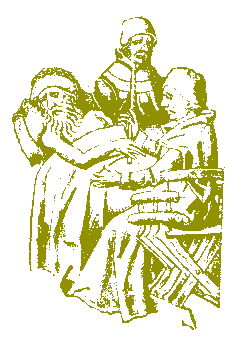| SOME NOTES ON MEDIEVAL ENGLISH GENEALOGY | ||||
| HOME | GUIDE | SOURCES | FAMILIES | RESOURCES |
| LINKS | CALENDAR |
Request updates WHAT'S NEW |
THIS SITE | SEARCH |

For obvious reasons, wills are among the genealogist's favourite documents. But of course, they are not a modern invention. The Romans used them and, closer to home, the Anglo-Saxons left written records specifying what was to happen to their property after death. However, the will in a recognisably modern form did not evolve until the late 13th century. Medieval wills, like those from more recent times, are the most 'personal' documents most people were likely to leave behind, and among the likeliest to contain details of family relationships. Nor were they exclusively the preserve of the wealthy - manorial tenants could make them - although, then as now, wills were more likely to be made by those who had more to leave.
Inevitably, there are ways in which medieval wills differ from modern wills, and difficulties in using them. Because early wills were often primarily concerned with arrangements for burial and gifts to the church, in later times they fell almost entirely under the jurisdiction of the ecclesiastical courts - a situation that continued until 1858. As a result, there were several hundred courts with probate jurisdiction in England and Wales, many of them very small. Survival of early wills is patchy: a few series of wills - in bishops' registers, corporation records and ecclesiastical courts - begin in the 13th century, but many more around the late 14th, and some not until the late 15th.
Medieval wills are likely to survive as transcripts in a register, rather than as original documents. Before about 1500, most are written in Latin - or occasionally French - and handwriting can present problems (the record of probate continued to be made in Latin until the 18th century). On the positive side, the vocabulary of wills is typically small and the phraseology standardised, so that with a little practice most of the problems can be overcome.
Another very noticeable difference from modern wills is the heavy religious emphasis, which largely persisted until the Reformation. Almost invariably, the late medieval will begins by bequeathing the soul to God, then specifies the place of burial, and then often arranges for the funeral and for masses to be said for the testator. There is then, commonly, a list of legacies to parish churches and religious houses. Sometimes, to the disappointment of the genealogist, there is little more beyond this, other than the naming of executors and witnesses. Even in such cases, the religious legacies may contain valuable information - the parishes mentioned are usually those where the testator held lands, and the choice of religious houses may indicate a particular connection with the family.
Usually, members of the family are also named. However, it is worth bearing in mind that, to a greater extent than in modern wills, children may well have been previously provided for, and the disposal by will of most landed property was, in theory, prohibited in medieval times. So it's rarely safe to draw conclusions from the lack of a reference in a medieval will to children or a wife. On the other hand, one positive difference from later wills is that medieval testators often provided for the spiritual welfare of members of the family who were already dead. The testator's parents may well be named, together with even more remote ancestors if one is very lucky.
Searching for wills can be complicated because there were so many different probate courts, and the geographical areas covered by them often overlapped. There are several published guides describing probate jurisdictions (see below). Fortunately, there are also printed indexes of testators for most courts, at least for the medieval and early modern period. A large number of individual wills have also been printed, either as Latin (or English) transcripts, or as English translations or abstracts.
Available online:
Published works:
The following web page lists probate indexes (on paper and online) that have appeared since the publication of Gibson and Churchill's bibliography in 2002:
| Funeral monuments > |